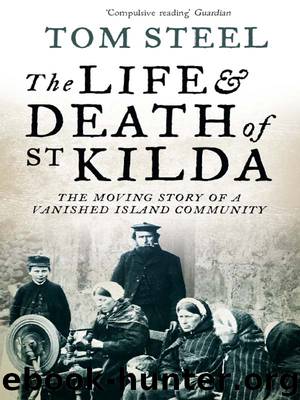The Life and Death of St. Kilda: The Moving Story of a Vanished Island Community by Tom Steel

Author:Tom Steel [Steel, Tom]
Language: eng
Format: epub
Tags: History, Europe, Great Britain
ISBN: 9780007438013
Google: cws-q1hKs_AC
Amazon: B005IH0M7G
Publisher: HarperPress
Published: 2011-09-21T23:00:00+00:00
11
The beginning of the end
A German submarine surfaced at the head of Village Bay at precisely 10.40 in the morning on 15 May 1918. ‘We had a phone down to the wireless,’ recalls Neil Gillies, then a young man, more enthusiastic about being at war than were his elders, ‘and we phoned down that the submarine was making for the bay. He came quite close, to the point where you could have flung a stone right into the conning tower.’ The captain, in the best English he could muster, warned the St Kildans over a loud-hailer that he was about to shell the island in order to destroy the Navy’s wireless station. The islanders took rapid cover in the Dry Burn, a deep gully that lay behind the village street. The captain fired seventy-two shells: the St Kildans were literally bombarded into the twentieth century.
Shortly after the outbreak of the First World War, the Admiralty decided to send a naval detachment to St Kilda. If nature had designed a place suited to the observation of shipping in the North Atlantic, it was Hirta. The island became a War Signal Station, and on 12 January 1915 the first naval personnel under the command of Captain Frank Athow, RMLI (Retd), landed there. The little party comprised two Petty Officers, twelve ratings, and a Marine batman. Their first concern was to put right the old wireless donated by the Daily Mirror. Although Captain Athow had been on the retired list since the Boer War, somehow he and his men managed to get the old Marconi set operational, and regular daily communication was kept up with the Naval Centre at Aultbea in Wester Ross.
They were good days for the St Kildans. Apart from being in constant radio contact with the mainland, the islanders were able to buy supplies from the tiny garrison which was regularly supplied with food by HMS Cyclops based at Scapa Flow, and later by His Majesty’s Depot Ship Manco, which worked out of Stornoway. The personnel was changed every four months by the Navy in case the men should find the isolation of St Kilda too much for them. Mail was delivered from the mainland every week, and the islanders were able to make use of the service. Armed trawlers and whalers based at Stornoway provided the people with that luxury throughout the entire period of the war, in winter as well as summer.
The St Kildans became prosperous during the first war they had ever been involved in. Money circulated freely, not only among the men of the Navy but also among the islanders. Most of the St Kildan men were employed round the village area – digging trenches, erecting the wooden prefabricated huts sent over from the mainland to accommodate the detachment, and laying telegraphic cables from the look-out posts in the hills to the wireless station. Some were employed by the Navy to act as watchmen, at a pay of two shillings a day. The look-out posts were
Download
This site does not store any files on its server. We only index and link to content provided by other sites. Please contact the content providers to delete copyright contents if any and email us, we'll remove relevant links or contents immediately.
| Africa | Americas |
| Arctic & Antarctica | Asia |
| Australia & Oceania | Europe |
| Middle East | Russia |
| United States | World |
| Ancient Civilizations | Military |
| Historical Study & Educational Resources |
Room 212 by Kate Stewart(4732)
The Crown by Robert Lacey(4570)
Endurance: Shackleton's Incredible Voyage by Alfred Lansing(4501)
The Iron Duke by The Iron Duke(4119)
The Rape of Nanking by Iris Chang(4021)
Killing England by Bill O'Reilly(3896)
Joan of Arc by Mary Gordon(3782)
Say Nothing by Patrick Radden Keefe(3725)
I'll Give You the Sun by Jandy Nelson(3269)
Shadow of Night by Deborah Harkness(3173)
Hitler's Monsters by Eric Kurlander(3161)
Mary, Queen of Scots, and the Murder of Lord Darnley by Alison Weir(3062)
Blood and Sand by Alex Von Tunzelmann(3055)
Darkest Hour by Anthony McCarten(3017)
Margaret Thatcher: The Autobiography by Thatcher Margaret(2969)
Eleanor & Park by Rainbow Rowell(2943)
Red Famine: Stalin's War on Ukraine by Anne Applebaum(2814)
Book of Life by Deborah Harkness(2716)
The One Memory of Flora Banks by Emily Barr(2684)
